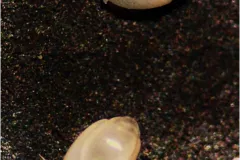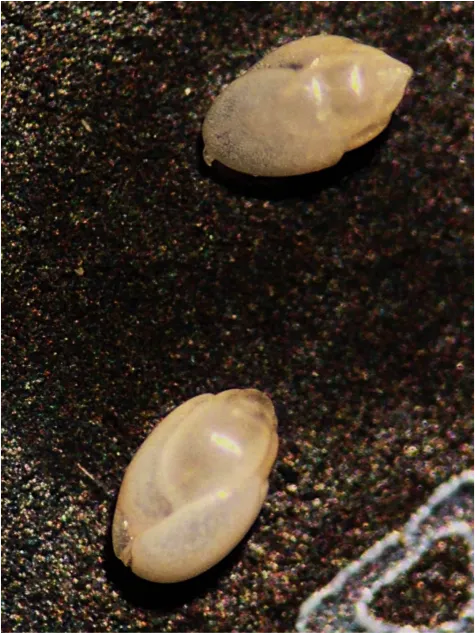Little Critters that tell a BIG Story: Benthic Foraminifera and the Gulf Oil Spill

You are not alone if you don’t know what forams (short for foraminifera) are, so let’s start with the basics. Simply put, forams are single-celled organisms related to the familiar amoeba that produce a hard shell. These shells look like the shells you might pick up on the beach, but they are much smaller—most are between 0.05 and 0.5 mm (about the size of a pencil tip). Forams are important organisms in their own right. They eat decomposing plants and animals, turning them into useful minerals. Forams are also a source of food for many worms, crustaceans, snails, echinoderms (like sea urchins and starfish), and fish.
But forams are extra important for scientists to study because they are indicator species. Forams are very sensitive to changes in their environment and can help us piece together a story of what is happening on the seafloor. When the water or sediment they live in becomes more toxic (such as after an oil spill or when other pollution enters the area), typically the entire foraminifera community begins to change. Additionally, if there is pollution in the area, forams will sometimes incorporate those pollutants into their shells, which scientists can examine later—like a backup of your computer files that you keep safe for later use. Observing changes in diversity (who is there), abundance (how many are there), and shell chemistry (what they are made of) gives us a signal that the ecosystem might be out of balance.
Enter the Deepwater Horizon spill of 2010, when 3.19 million barrels of oil were released into the Gulf of Mexico. As with most oil spills, much of the attention focused on how sea turtles, seabirds and other large animals coped with the oil. It's easy to forget the smaller creatures like forams when images of oil-soaked birds and mammals fill the news. But my work primarily focuses on the forams, in particular their decline, recovery, and changes in shell chemistry, as a way of understanding other impacts of the oil spill. In late 2010 and early 2011, a few months after oil stopped flowing into the Gulf, we collected forams from various seafloor locations close to the origin of the spill to see whether the oil had changed the community. We collected them using a multicore device, which takes a two-foot core sample of seafloor sediment. There were nearly no benthic forams in the surface of the cores we took, indicating that the area was toxic. Back in the lab, we analyzed their shells and found that the few forams found in the surface of the cores had incorporated components of the oil. This showed us chemically what the toxic event was—the oil from the 2010 spill.
We returned to sample the seafloor in September 2011 and then again in 2012 to look for further changes in the foram community. By 2011, there were more forams in certain areas, but most of the communities were dominated by just a few species. These species are unique because they thrive in environments with little oxygen, where few other organisms or forams are able to survive at all. However, in other areas, we did not see any signs of recovery in the number or diversity of forams. Not until 2012 did the forams really begin to show evidence of recovery on the seafloor.
The changes in the foram community over time gave us valuable insights into how the oil spill affected the seafloor ecosystem as a whole. First, the increased abundance of foram species that thrive in low-oxygen environments showed us that the oil spill caused low-oxygen areas on the seafloor. In these areas, it's likely that many other larger organisms are also less abundant due to the low oxygen—a subject we are currently investigating. Second, other organisms that eat forams were likely affected. A complete community decline in abundance (such as the one in late 2010 and early 2011) could disrupt the food chain, since forams are an important food source for many animals that live on the seafloor.
We continue to return and census the community of forams every year in the Gulf of Mexico. As of 2012, some areas have fully recovered in abundance and diversity, but others are still dominated by those foram species that thrive in areas of low-oxygen. We continue to return to the same areas to collect samples over the years to help give us a basic and essential understanding of how long it takes for the organisms living at the seafloor to recover following a toxic event such as the Gulf oil spill.
Our Research is funded by the Gulf of Mexico Research Initiative (GOMRI) through both the Center for Integrated Modeling and Analysis of Gulf Ecosystems (CIMAGE) and the Deep Sea to Coast Connectivity in the Eastern Gulf (DEEP-C) consortia which are based at the University of South Florida and Florida State University respectively.
The Gulf of Mexico Research Initiative (GoMRI) is a 10-year independent research program established to study the effect, and the potential associated impact, of hydrocarbon releases on the environment and public health, as well as to develop improved spill mitigation, oil detection, characterization and remediation technologies. For more information, visit http://gulfresearchinitiative.org/.


